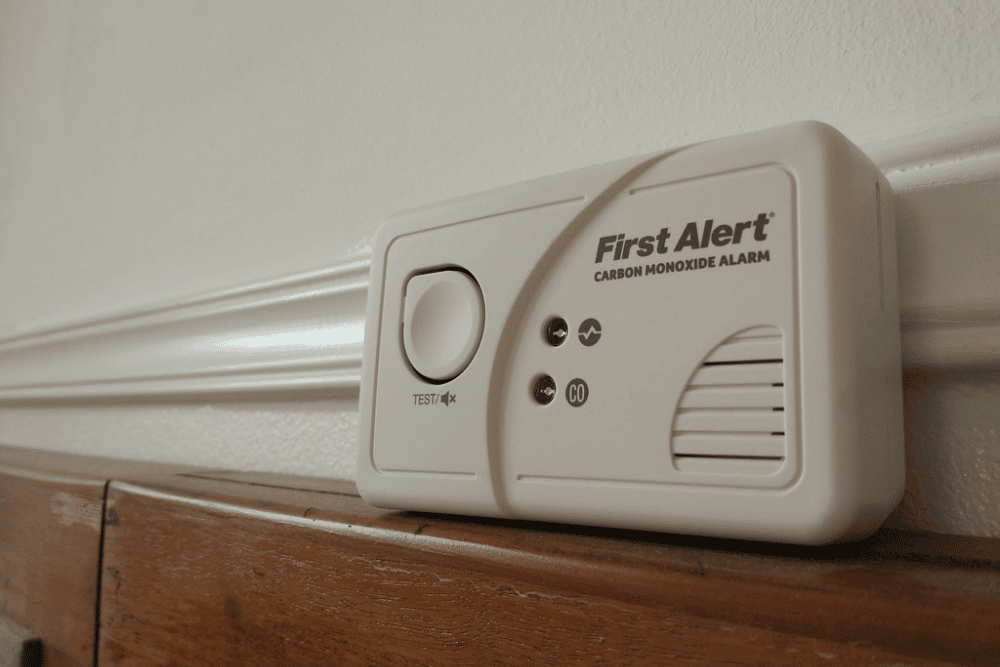What to Do If You Hear a Carbon Monoxide Detector Going Off

Do you hear a chirping noise in your home that isn’t quite as enjoyable as crickets on a summer night? That chirping, although somewhat annoying, plays a significant role in protecting you and your family by preventing death or serious illness. That noise is your carbon monoxide detector. So what do you do when you hear your carbon monoxide detector going off?
Carbon Monoxide: The Basics
Carbon monoxide (CO) is a colorless, odorless gas. It’s created whenever fuel is burned and can build up if not ventilated properly. And you really don’t want to breathe it in. Prolonged exposure can poison animals and people, which sometimes proves fatal. Because you can’t see or smell carbon monoxide, it’s sometimes called a “silent killer.”
According to the CDC, more than 10,000 people in the United States are poisoned by carbon monoxide each year and require medical attention. Even more shocking, more than 430 people die each year. That’s a horrific statistic, given the access we have to such a simple tool that can warn you of danger before it’s too late.
The main carbon monoxide emitters you may have around your home include:
- Fuel-burning appliances like your furnace, water heater, or laundry dryer (if not electric)
- Combustion engines, found in vehicles, generators, lawn equipment, and the like
- Obstructed, sooty chimneys
- Charcoal grills
- Generators
- Tobacco
- Some paint removers
About half of U.S. states require a carbon monoxide detector in every residential and commercial building. However, even if it’s not required in your state, it’s still a good idea to have a carbon monoxide detector. After all, most buildings contain something that emits carbon monoxide.
The “Chirp”
That chirping noise is purposefully annoying, but it’s actually very important. It’s letting you know that the carbon monoxide detector needs inspection. The noise may indicate a few different issues, so it’s vital that you address them as soon as possible. Never ignore when an alarm is notifying you of a problem.
The chirp of a carbon monoxide detector is distinctly different from the alarm that it emits. Be sure to familiarize yourself with both sounds. A chirping noise can mean that the detector is reaching the end of its lifespan, a low battery warning, an improperly installed battery, an alarm malfunction, or a loose electrical connection. Refer to your carbon monoxide detector’s owner’s manual for exact details.
It’s common practice to change the batteries in your detectors at least once a year. So if you’re currently hearing a chirping noise, that’s a good place to start the diagnostic process. Swapping out the batteries will usually do the trick, but depending on your specific carbon monoxide detector, there may be a reset sequence you’ll also need to perform to get the chirping to stop. If you’re looking for instructions on how to reset a carbon monoxide alarm, you’ll have to reference your owner’s manual. Every model is different.
Red Blinking Light
Many carbon monoxide detectors come equipped with a flashing indicator light, which is another way the detector can notify you of a problem. Most detectors indicate they’re operating normally by a steadily flashing green light. When you notice a red light flashing, there’s likely an issue.
Determining the meaning of the detector’s color and blinking pattern depends on the specific make and model. But in general, these lights are a power source indicator. If the light is blinking red, it may indicate a low battery life or power source connection issues. However, some models may use the light to indicate when carbon monoxide has been detected. Refer to your carbon monoxide detector’s owner’s manual for exact details.
What Else Could It Be?
Still hear your carbon monoxide detector going off, even after checking the usual suspects? If you’ve performed all diagnostics listed in your owner’s manual and the chirping persists, you may need to replace the current carbon monoxide detector.
It’s important to know the age of the detector. The back of your detector should be stamped with its expiration date or date of manufacture. The lifespan of the average carbon monoxide detector is approximately 5-7 years. It’s important to replace an expired detector, as they become less sensitive to CO particles over time. In other words, that old detector might not be able to keep you safe.
Carbon Monoxide Detector ALARM
A carbon monoxide detector alarm is significantly different from the chirping noise it can make. It may be a steady and loud pattern of beeping or even an automated voice warning you that carbon monoxide has been detected. If you ever hear your carbon monoxide alarm sounding, have everyone in the house go outside immediately.
Once outside, check everyone over for signs of illness. Poisoning may manifest as flu-like symptoms, including aches, dizziness, weakness, and nausea. Call an emergency medical response team if necessary. If possible, do not re-enter your home until the alarm stops sounding or emergency responders deem your home safe.
Protect Your Home in Every Way
Whole-home safety requires vigilance against dangers of all kinds. That includes both internal threats (like carbon monoxide) and external threats (like a burglar). A holistic home security plan involves multiple layers of protection to address each of these threats.
In addition to a functional, well-maintained carbon monoxide detector, your home should also have:
- Smoke alarms
- Solid doors with sturdy locks
- Exterior lighting
- A list of important phone numbers for emergencies (such as Poison Control)
- An easily accessible fire extinguisher
- Window treatments that block views from the street
- Flashlights and extra batteries
- A rescue ladder (for multi-story homes)
- Outdoor cameras with 24/7 live video surveillance
For ultimate protection, make Deep Sentinel’s industry-leading security camera system part of your whole-home security plan.